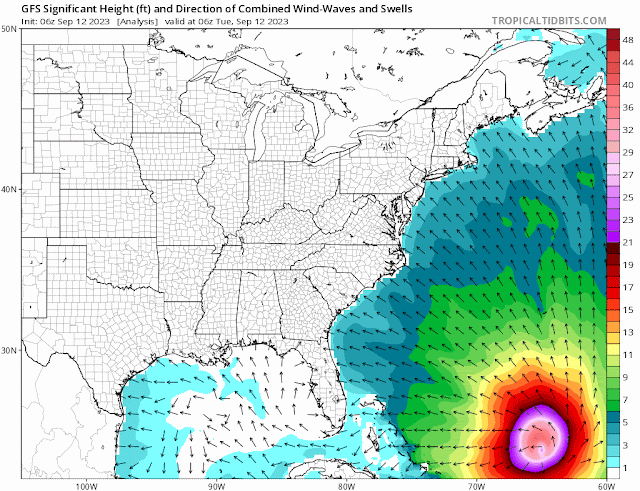Tropical Depression 17 formed on Saturday morning and was upgraded to Tropical Storm Philippe shortly afterward... and Tropical Storm Rina just formed on Thursday morning. Both are located east of the Lesser Antilles and most likely will not affect land. They are rather close together and in this satellite loop, it's even hard to tell them apart! (Philippe is west of Rina)
Philippe has been hovering as a mid-range tropical storm all week, and its future is very interesting and uncertain... much more than normal. This example is from the American global model (GFS) ensemble and is representative of the spread we're seeing in the other models. One cluster dissipates the storm or at least keeps it weak as it heads west toward the Caribbean, while another cluster stalls, turns north, and becomes a strong hurricane. In a few of the scenarios, this could be a close call for the extreme northeast Caribbean islands, so certainly something to pay close attention to there. The NHC forecast is a hybrid of these outcomes: their forecast takes it west, then turning north well before reaching the islands, but keeping the intensity steady as a weak tropical storm.
Tropical Storm Rina is located just 650 miles east of Philippe and is not expected to strengthen much. It is the 18th named storm of the season... keep in mind the climatological average number of named storms in an entire season is 14. There are a couple reasons for its modest intensity outlook: the proximity to Philippe and increasing vertical wind shear.
The Accumulated Cyclone Energy, or ACE, is at about 132% of average for the date, and 99% of an average full-season's total. Impressively, today is the 40th consecutive day of ACE accrual... the activity has been nonstop from Emily through Rina!
Although there are no other features of interest out there to monitor yet, the next couple of names on the list are Sean and Tammy. As we head into October, activity from Africa begins to dwindle, and we start looking to the western Caribbean and Gulf of Mexico for formation areas. The ocean temperature in these areas is also very warm compared to normal for this time of year, so not only does that give incipient storms a nudge, the area of "favorable" warm water is larger than normal too.
- Visit the Tropical Atlantic Headquarters.
- Subscribe to get these updates emailed to you.
- Follow me on Bluesky and X










.gif)

 Since my
Since my 













 Unfortunately, I did not get a chance to write a post on Friday... and the reason it's unfortunate is that a very rare explosive intensification had just concluded with Hurricane Lee. Only two other storms intensified more rapidly than Lee did in the Atlantic: Wilma 2005 and Felix 2007. The sustained winds increased by 85mph in a day, going from a low-end Category 1 hurricane (80mph) to a Category 5 hurricane (165mph). There were frequent aircraft reconnaissance flights into the storm that sampled the intensity very well.
Unfortunately, I did not get a chance to write a post on Friday... and the reason it's unfortunate is that a very rare explosive intensification had just concluded with Hurricane Lee. Only two other storms intensified more rapidly than Lee did in the Atlantic: Wilma 2005 and Felix 2007. The sustained winds increased by 85mph in a day, going from a low-end Category 1 hurricane (80mph) to a Category 5 hurricane (165mph). There were frequent aircraft reconnaissance flights into the storm that sampled the intensity very well.
.gif)




 As expected, Lee is rapidly intensifying east of the Leeward Islands and is now officially forecast to be a Category 5 hurricane on Friday-Saturday. Additionally, the easterly wave I mentioned yesterday that was near Cabo Verde has been upgraded to Tropical Depression 14 and is likely to become the season's fifth hurricane this weekend. Its name will be Margot.
As expected, Lee is rapidly intensifying east of the Leeward Islands and is now officially forecast to be a Category 5 hurricane on Friday-Saturday. Additionally, the easterly wave I mentioned yesterday that was near Cabo Verde has been upgraded to Tropical Depression 14 and is likely to become the season's fifth hurricane this weekend. Its name will be Margot..gif)



 A well-organized easterly wave left the African continent last Friday (Sept 1) and was upgraded to Tropical Depression 13 and then again to Tropical Storm Lee on Tuesday (Sept 5). As of midday Wednesday it is nearly a hurricane and is expected to become the season's 4th hurricane later today.
A well-organized easterly wave left the African continent last Friday (Sept 1) and was upgraded to Tropical Depression 13 and then again to Tropical Storm Lee on Tuesday (Sept 5). As of midday Wednesday it is nearly a hurricane and is expected to become the season's 4th hurricane later today.


.gif)

